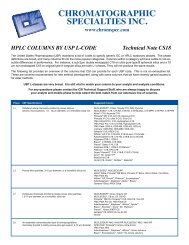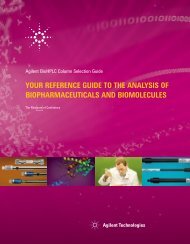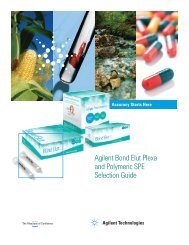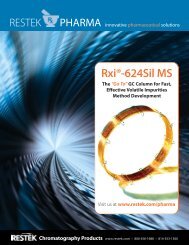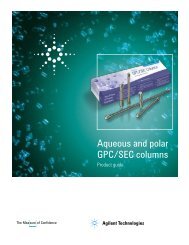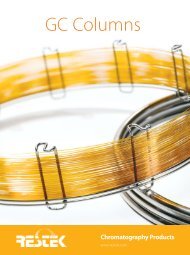Optimizing the Analysis of Volatile Organic Compounds
Optimizing the Analysis of Volatile Organic Compounds
Optimizing the Analysis of Volatile Organic Compounds
You also want an ePaper? Increase the reach of your titles
YUMPU automatically turns print PDFs into web optimized ePapers that Google loves.
Purge and Trap Theory<br />
Concentration <strong>of</strong> <strong>Volatile</strong> <strong>Organic</strong>s<br />
<strong>Volatile</strong> organic compounds can be concentrated by ei<strong>the</strong>r static headspace or dynamic<br />
headspace (i.e., purge and trap) sampling. In static headspace concentration, a sample is<br />
placed in a closed sample chamber. Molecules <strong>of</strong> <strong>the</strong> volatile compounds in <strong>the</strong> sample<br />
migrate to <strong>the</strong> headspace above <strong>the</strong> sample and equilibrium is established between <strong>the</strong> concentration<br />
<strong>of</strong> <strong>the</strong> compounds in <strong>the</strong> vapor phase and in <strong>the</strong> liquid phase (Figure 3). Once<br />
equilibrium is reached, an aliquot <strong>of</strong> <strong>the</strong> headspace above <strong>the</strong> sample is injected onto <strong>the</strong> GC<br />
column. A major problem with static headspace techniques is that <strong>the</strong> sample matrix significantly<br />
affects equilibrium. Analyses for compounds that show high solubility in <strong>the</strong> sample<br />
matrix <strong>of</strong>ten yield low sensitivity as a result <strong>of</strong> matrix effects. Fur<strong>the</strong>r, static headspace<br />
analysis only samples an aliquot <strong>of</strong> <strong>the</strong> volatiles (i.e., 1mL, 2mL, or whatever <strong>the</strong> size <strong>of</strong> <strong>the</strong><br />
sample loop), which also affects sensitivity.<br />
volatile<br />
analyte<br />
Figure 3.<br />
<strong>Volatile</strong> analyte in equilibrium between <strong>the</strong> gas and sample phases.<br />
G=gas phase (headspace)<br />
The gas phase, commonly referred to as <strong>the</strong> headspace,<br />
is above <strong>the</strong> sample phase.<br />
} G S=sample phase<br />
The sample phase contains <strong>the</strong> compound(s) <strong>of</strong> interest,<br />
usually in <strong>the</strong> form <strong>of</strong> a liquid or solid in combination<br />
}<br />
with a dilution solvent or a matrix modifier.<br />
S<br />
Once <strong>the</strong> sample phase is introduced into <strong>the</strong> vial and<br />
<strong>the</strong> vial is sealed, molecules <strong>of</strong> <strong>the</strong> volatile component(s)<br />
diffuse into <strong>the</strong> gas phase until <strong>the</strong> headspace reaches a<br />
state <strong>of</strong> equilibrium, as depicted by <strong>the</strong> arrows. An<br />
aliquot is <strong>the</strong>n taken from <strong>the</strong> headspace.<br />
Purge and trap concentration is a dynamic headspace technique that reduces matrix effects<br />
and increases sensitivity, relative to static headspace techniques. Samples containing VOCs<br />
are introduced into a purge vessel and a flow <strong>of</strong> inert gas is passed through <strong>the</strong> sample at a<br />
constant flow rate for a fixed time. <strong>Volatile</strong> compounds are purged from <strong>the</strong> sample into <strong>the</strong><br />
headspace above <strong>the</strong> sample and are transferred to and concentrated on an adsorbent trap<br />
(Figure 4). After <strong>the</strong> purging process is complete, <strong>the</strong> trap is rapidly heated and backflushed<br />
with carrier gas to desorb and transfer <strong>the</strong> analytes to <strong>the</strong> GC column.<br />
Figure 4.<br />
The purging process transfers <strong>the</strong> VOCs from <strong>the</strong> sample to <strong>the</strong> GC column.<br />
GC<br />
4<br />
3<br />
5<br />
2<br />
gas<br />
source<br />
6<br />
1<br />
trap<br />
out to vent<br />
The purge and trap concentrator in “purge” mode.<br />
The 6-port valve allows carrier gas to bubble<br />
through <strong>the</strong> aqueous sample, transferring volatiles<br />
to <strong>the</strong> adsorbent material.<br />
4<br />
3<br />
The purge and trap concentrator in<br />
“desorb” mode. VOCs concentrated on <strong>the</strong> trap<br />
are desorbed to <strong>the</strong> chromatograph for separation,<br />
identification and quantification.<br />
5<br />
2<br />
6<br />
1<br />
Sample purging in progress in a<br />
Tekmar 3100 concentrator.<br />
7<br />
www.restekcorp.com





